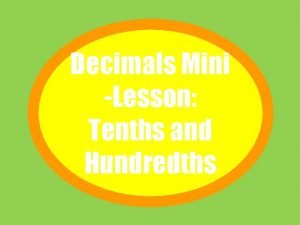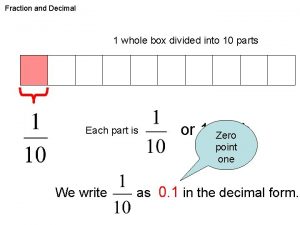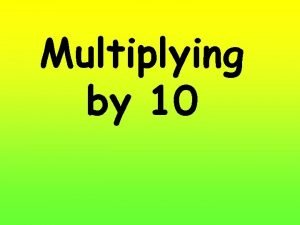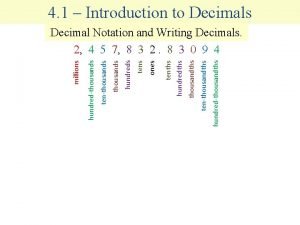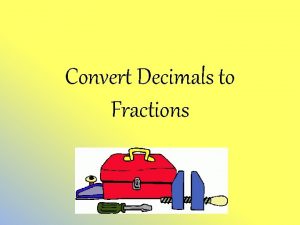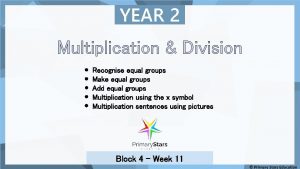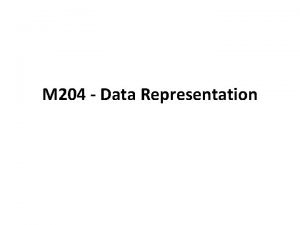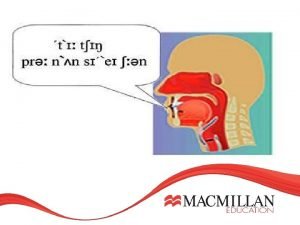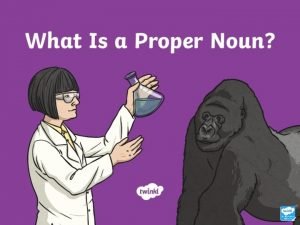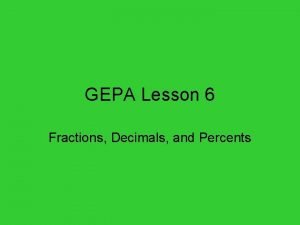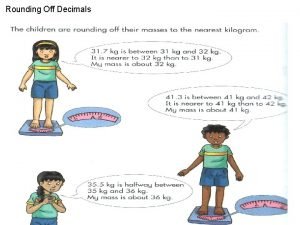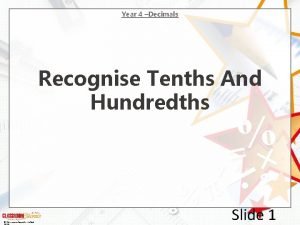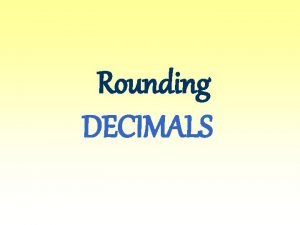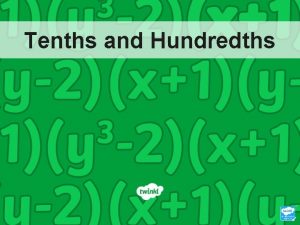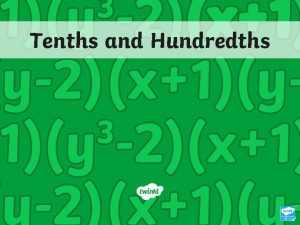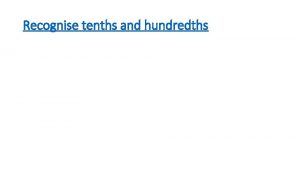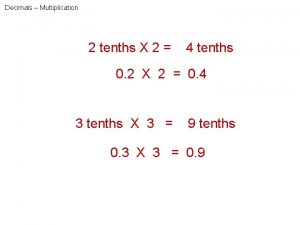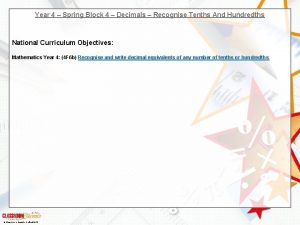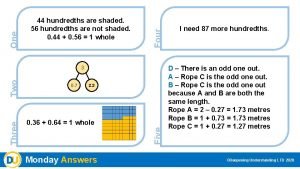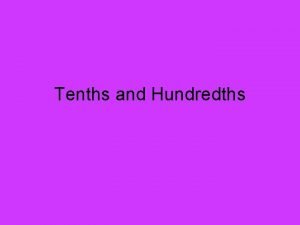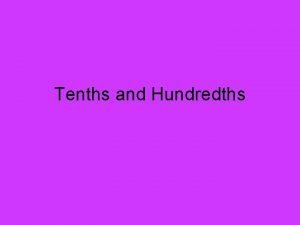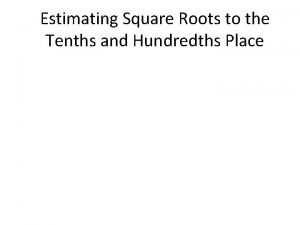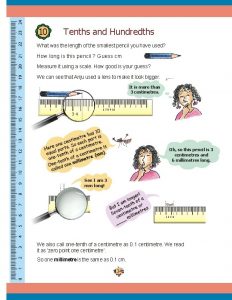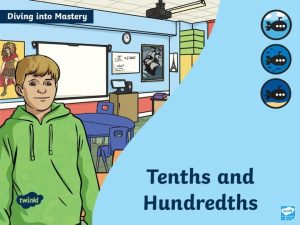Year 4 Decimals Recognise Tenths And Hundredths Classroom

















- Slides: 17

Year 4 –Decimals Recognise Tenths And Hundredths © Classroom Secrets Limited Slide 1

Introduction What fraction of each shape has been shaded? These are similar to the Dienes that we use in school. What type of Dienes are these – which one is the 10; Which one is the 100? (On the left is the 10 and on the right is the 100. ) How many of the 10 dienes are coloured blue? How many 10 dienes are there in total? How would this look as a fraction? How many of the 100 dienes are coloured green? How many 100 dienes are there in total? How would this look as a fraction? Numerator-how many parts are coloured. Denominator-the total number of parts (dienes). © Classroom Secrets Limited Slide 2

Introduction What fraction of each shape has been shaded? 1 10 0 © Classroom Secrets Limited 1 10 0 0 Slide 3

Varied Fluency 1 Complete the statement and shade the hundred square to match. 47 hundredths can be partitioned into ___ tenths and ___ hundredths. Before you answer think about the following – • How many of the hundredths squares do you need to make up ONE tenth? • How many tenths are there in the number 47? Once you have answered this you will know how many squares to colour in. • How many hundredths are there? © Classroom Secrets Limited Slide 4

Varied Fluency 1 Complete the statement and shade the hundred square to match. 47 hundredths can be partitioned into 4 tenths and 7 hundredths. © Classroom Secrets Limited Slide 5

Varied Fluency 2 Fill in the missing numbers to complete the part-whole model. 76 10 0 0 How many tenths are there? (the numerator) How many parts are there in total? 6 10 The answer for this Part-Whole model are found on this page. © Classroom Secrets Limited Slide 6

Varied Fluency 2 Fill in the missing numbers to complete the part-whole model. 76 10 0 0 7 10 © Classroom Secrets Limited 6 10 0 Slide 7

Varied Fluency 3 Partition the following numbers into tenths and hundredths. A. B. © Classroom Secrets Limited 59 10 0 0 16 10 0 0 = = 10 10 and 100 Slide 8

Varied Fluency 3 Partition the following numbers into tenths and hundredths. A. B. © Classroom Secrets Limited 59 10 0 0 16 10 0 0 = = 5 10 1 10 and 9 100 6 100 Slide 9

Varied Fluency 4 Complete the part whole models below. 8 10 © Classroom Secrets Limited 10 10 0 5 10 20 10 0 Slide 10

Varied Fluency 4 Complete the part whole models below. 90 10 0 8 10 © Classroom Secrets Limited 70 10 10 0 5 10 20 10 0 Slide 11

Reasoning 1 Freddie has completed the bar model to represent 5 tenths and 1 hundredth. 5 10 51 10 0 Explain the mistake Freddie has made. © Classroom Secrets Limited Slide 12

Reasoning 1 Freddie has completed the bar model to represent 5 tenths and 1 hundredth. 5 10 51 10 0 Explain the mistake Freddie has made. Freddie is incorrect because… © Classroom Secrets Limited Slide 13

Reasoning 1 Freddie has completed the bar model to represent 5 tenths and 1 hundredth. 5 10 51 10 0 Explain the mistake Freddie has made. Freddie is incorrect because he has partitioned the number into 5 tenths and 51 hundredths, rather than 5 tenths and 1 hundredth. © Classroom Secrets Limited Slide 14

Reasoning 2 Jaxon has represented 16 hundredths in two different ways. 16 10 1 0 10 16 10 0 Is he correct? Explain your answer. © Classroom Secrets Limited Slide 15

Reasoning 2 Jaxon has represented 16 hundredths in two different ways. 16 10 1 0 10 16 10 0 Is he correct? Explain your answer. Jaxon is incorrect because… © Classroom Secrets Limited Slide 16

Reasoning 2 Jaxon has represented 16 hundredths in two different ways. 16 10 1 0 10 16 10 0 Is he correct? Explain your answer. Jaxon is incorrect because the part-whole model does not show 1 the correct number of tenths. It should say instead. 10 © Classroom Secrets Limited Slide 17
 47 hundredths
47 hundredths Model tenths and hundredths
Model tenths and hundredths Tenths hundredths thousandths
Tenths hundredths thousandths What is 0·125zero point one two five as a fraction?
What is 0·125zero point one two five as a fraction? Ones tenths hundredths
Ones tenths hundredths Tenths and units
Tenths and units Decimals tens hundreds thousands
Decimals tens hundreds thousands 11111 as a fraction
11111 as a fraction Recognise equal groups year 2
Recognise equal groups year 2 204
204 Recognise pronunciation
Recognise pronunciation Proper noun for day
Proper noun for day Comparing decimals year 5
Comparing decimals year 5 Two sevenths as a decimal
Two sevenths as a decimal Round off 52
Round off 52 Btech smart classes
Btech smart classes 16 hundredths
16 hundredths Decimal for 3/8
Decimal for 3/8

